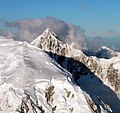| Kahiltna Queen | |
|---|---|
 Aerial view from WSW | |
| Highest point | |
| Elevation | 12,380 ft (3,773 m) [1] [2] |
| Prominence | 1,430 ft (440 m) [1] |
| Parent peak | Peak 13050 [1] |
| Isolation | 1.46 mi (2.35 km) [1] |
| Coordinates | 62°58′49″N 151°02′27″W / 62.980372°N 151.040952°W [3] |
| Geography | |
| Country | United States |
| State | Alaska |
| Borough | Matanuska-Susitna |
| Protected area | Denali National Park |
| Parent range | Alaska Range [3] |
| Topo map | USGS Talkeetna D-3 |
| Geology | |
| Mountain type | Glacial horn |
| Type of rock | Granite [4] |
| Climbing | |
| First ascent | 1977 |
Kahiltna Queen is a 12,380-foot-elevation (3,773-meter) mountain summit in the U.S. state of Alaska.
Description
Kahiltna Queen is located 140 miles (225 km) north of Anchorage in Denali National Park and the Alaska Range. It is situated east of the Denali Base Camp for mountaineers attempting to climb Denali, Mount Foraker, or Mount Hunter. Kahiltna Queen is set 6.24 mi (10 km) south of Denali's summit, 3.63 mi (6 km) south of Kahiltna Peaks, and 2.62 mi (4 km) northeast of Hunter. [3] Access to the area is via air taxi from Talkeetna. The peak has the shape of a steep glacial horn sculpted by three glaciers as it rises above the heads of West Fork Ruth Glacier, Southeast Fork Kahiltna Glacier, and the Tokositna Glacier. Topographic relief is significant as the summit rises 3,400 feet (1,036 meters) above the Tokositna Glacier in one-half mile (0.8 km). The peak ranks as the 54th-highest summit in Alaska. [2] The first ascent of the summit was made in April of 1977 by Alan Kearney, Mai Ulrich, and Chuck Sink who christened it "Humble Peak." [5] [6]
Etymology
The mountain's toponym commemorates Frances Randall (1925-1984), the first Denali Base Camp manager for nine climbing seasons (1974-1983). [7] She was planning a tenth season, but cancer claimed her life. [8] Her expertise was instrumental in coordinating many rescues that saved lives and earned her the nicknames Kahiltna Queen and Guardian Angel of McKinley. [9] She was a member of the Fairbanks Symphony Orchestra, often playing the violin at base camp over the CB radio. In 1964 she became the sixth woman to reach the summit of Mount McKinley. "Kahiltna" is a Athabaskan word meaning "from the source." [10]
Climate
Based on the Köppen climate classification, Kahiltna Queen is located in a Tundra climate zone with long, cold, snowy winters, and cool summers. [11] Weather systems are forced upwards by the Alaska Range ( orographic lift), causing heavy precipitation in the form of snowfall. Winter temperatures can drop below −20 °F with wind chill factors below −30 °F. The months May through June offer the most favorable weather for viewing and climbing. [12]
See also
Gallery
References
- ^ a b c d "Kahiltna Queen - 12,380' AK". listsofjohn.com. Retrieved 2023-11-12.
- ^ a b Highest Alaskan summits, National Park Service, nps.gov, Retrieved 2023-11-12.
- ^ a b c "Kahiltna Queen, Alaska". Peakbagger.com. Retrieved 2023-11-12.
- ^ Guided Alpine Climbing in the Alaska Range, American Alpine Institute, Retrieved 2023-11-12.
- ^ North America, United States, Alaska, Denali National Park, Peak 12,380' (Kahiltna Queen), South Face Couloir and Distant Lights, 2004, American Alpine Journal, americanalpineclub.org
- ^ West Face, Kahiltna Queen, Supertopo, supertopo.com, Retrieved 2023-11-12.
- ^ NPS 1984 Annual Report
- ^ Frances D Randall americanalpineclub.org
- ^ To the Top of Denali: Climbing Adventures on North America's Highest Peak, Bill Sherwonit author, Third Edition (2012), Alaska Northwest Books.
- ^ Sandy Nestor, Indian Placenames in America, Volume 1, McFarland, 2015, ISBN 9780786493395, p. 15.
- ^ Peel, M. C.; Finlayson, B. L.; McMahon, T. A. (2007). "Updated world map of the Köppen−Geiger climate classification" (PDF). Hydrol. Earth Syst. Sci. 11 (5): 1633. Bibcode: 2007HESS...11.1633P. doi: 10.5194/hess-11-1633-2007. ISSN 1027-5606.
- ^ Denali FAQ, American Alpine Institute, alpineinstitute.com, Retrieved 2024-01-08.
External links
- Weather forecast: Kahiltna Queen
- Kahiltna Queen (photo): Flickr
- Kahiltna Queen (photo): Flickr




